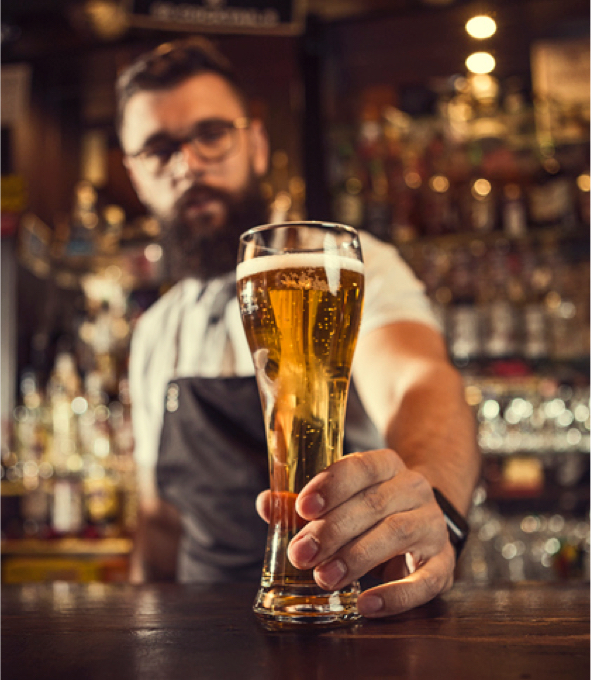Authored by Beau Hoy:
Like many industries, the food and beverage sector has experienced setbacks over the past two to three years. However, beverage gas suppliers and restaurants saw 2023 as an opportunity to overcome challenges and strengthen operations. But did 2023 prove to be a successful year? And how did trends require operations to evolve?
To best prepare your food and beverage business for the year ahead, let’s take a closer look at 2023 and the anticipated beverage gas supply trends for the food and beverage industry in 2024.
Beverage Gas: What We Saw in 2023
Last year, the food and beverage industry prioritized enhancing operational strategies and increasing supply chain stability. With new business best practices and the adoption of industry trends, food and beverage companies experienced two major shifts: steady customer demand and a focus on environmental impact. Let’s take a deeper dive into these 2023 trends.
Increased Customer Demand
Compared to 2022 – where we saw supply chain setbacks, increased labor costs, and labor shortages – the food and beverage industry maintained steady growth in 2023. A key driver for this growth was increased customer spending at restaurants. One report stated that, as of March 2023, restaurant spending increased by 13%, and consumers spent more money dining out than they did on groceries. Closing out 2023, food service sales reached $705 billion, down .1% from September 2023’s $705.7 billion revenue. Moreover, the seltzer industry experienced an influx of sales totaling $28.4 billion in revenue, signaling a significant increase for businesses that utilize beverage-grade CO2.
Restaurants and beverage companies have positively benefited from this demand. As customer demand rises, so does the need for beverage gas supply, specifically carbon dioxide gas. However, even as the industry is experiencing a return to normalcy, CO2 has the potential for volatility being a non-atmospheric gas.
Heightened Awareness Around Environmental Impact
Another major trend in 2023 was the continued focus on ESG initiatives across all industries, with an emphasis on CO2 footprint. Businesses began to develop sustainability best practices for managing and measuring their carbon footprint. This growing interest is partly due to the passing of the Inflation Reduction Act (IRA), which is federal legislation that aims to reduce carbon pollution by lowering U.S. greenhouse gas (GHG) emissions. One component of the IRA is offering incentives to ammonia and ethanol manufacturers. Those who choose to capture CO2 emissions and store them in the ground versus selling to industrial gas companies are eligible for incentives like tax credits. This change could put additional costs into the CO2 supply chain.
As a result of the IRA, outside industries that can use alternative gases, like nitrogen, are moving away from CO2. However, the food and beverage industry almost exclusively uses CO2 because it is the best product for carbonating beverages as well as food freezing and storage.
Beverage Gas Outlook for 2024
As we think about the year ahead, we expect a similar trajectory of continued growth and demand. While experts and businesses plan to account for regular cost increases across the industry, they have an optimistic outlook as supply capacity and demand have reached a level playing field. Companies will have the opportunity to maintain overall ROI and continue to develop and refine their overarching business strategies.
In terms of sustainability, as more businesses learn about the IRA and understand its benefits, we anticipate more awareness and implementation of sustainable business practices. From lowering emissions to using CO2 for the food and beverage sector, the industry is expected to benefit from stabilized CO2 demand. Moreover, CO2 is utilized by the marijuana industry for plant growth and extraction methods. As states have begun to legalize the use of marijuana, with 15 already having some form of medical cannabis program in place, we predict a rise in CO2 refills and demand will follow.
Strategies and Best Practices for Beverage Gas Supply
With less stress on maintaining equal levels of supply and demand, the beverage gas industry can take the time to look inward at what works for their customers and what needs fine-tuning. Gas suppliers and customers can start with safety and storage best practices to ensure they safely and efficiently package, transport, and deliver their gas supply. Businesses can also prioritize concerns like gas leakage and CO2 poisoning by investing in the right CO2 sensors and storage equipment, ensuring employee safety.
A main priority for all gas suppliers is ensuring customers have the gas supply they need when they need it. Communicating to customers when their next recommended order should occur or encouraging a double supply order not only strengthens supplier/customer communication but also reduces the number of delivery trips and optimizes supply chain operations.
As the industry continues to evolve and change, staying updated with the latest trends and recommended business strategies is equally important. There is value in attending conferences, tradeshows, and workshops, while also participating in webinars – specifically from established experts in gas supply such as gasworld and GAWDA – to learn what industry leaders predict and recommend. Turning this information into actionable insights can maximize operations and, if relayed to customers, can increase communication efforts.
Looking Ahead
As EspriGas prepares for the year ahead, we continue to analyze how our operations perform and how we can develop strategies and best practices to optimize our customers’ gas supply. By learning from 2023 trends and adopting 2024 best practices, we will continue to emphasize customer communication and ensure we support businesses every step of the way.

how we make ordering simple
The EspriGas Way
Fulfilling your beverage gas needs should be simple and easy. Our streamlined ordering process will help you get the right amount of gas, on-time with minimal effort.



